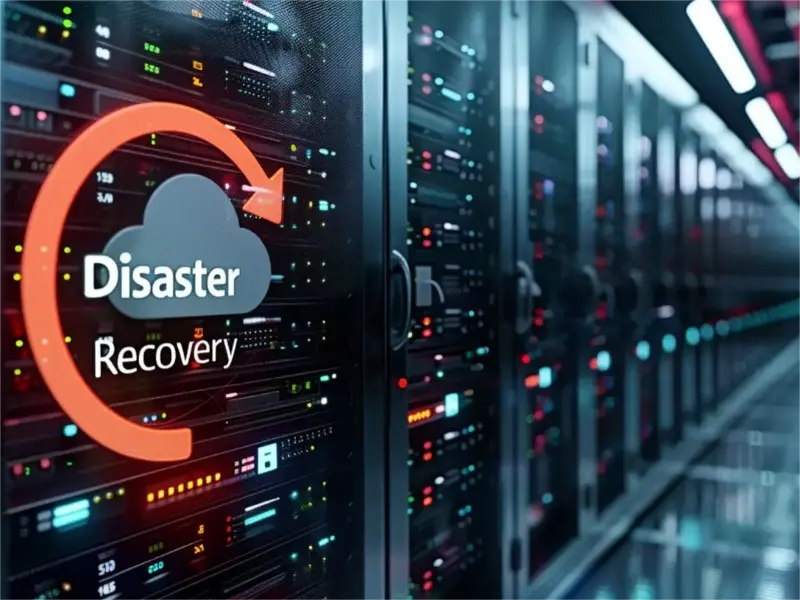- Data centre disaster recovery involves strategies and processes to recover data, restore hardware in the event of a disaster.
- A disaster recovery data centre is a secondary facility that serves as a backup to an organisation’s primary data centre
- This specialised plan focuses on protecting resources, aligning security protocols and ensuring rapid recovery to minimise downtime and data loss.
Data centre disaster recovery plan(DRP) is critical to maintaining business continuity and protecting valuable data from a range of threats, including cyber-attacks, human error and power outages. A comprehensive DRP includes detailed risk assessments, strategic backup protocols and robust redundancy measures to minimise business disruption. In the event of a disaster or disruption to the primary site, the disaster recovery centre takes over to ensure business continuity, protects the organisation’s reputation and controls financial losses.
What is data centre disaster recovery
A data centre DRP focuses on the overall security of a data centre facility and its ability to recover from an unplanned incident. Common threats to data centres include overstretched staff, which can lead to human error, cyber-attacks, power outages and difficulties in meeting compliance requirements.
Data centre DRPs create operational risk assessments that analyse key components such as the physical environment, connectivity, power sources and security. Because data centres face a wide range of potential threats, their IT DRPs tend to be broader in scope than others.
The importance of data centre disaster recovery
Business continuity: A well-designed disaster recovery plan enables critical business operations to continue in the face of a catastrophic event. This minimises downtime, reduces financial losses, helps maintain customer confidence and loyalty, and allows employees to continue working with minimal disruption. The ISO 22301 standard for Business Continuity Management Systems (BCMS) is a common certification that organisations pursue.
Data protection: Data is one of an organisation’s most valuable assets. Disaster recovery plans protect data from loss, corruption or unauthorised access in the event of a disaster, ensuring that critical information remains secure and accessible, and can be restored to its original state.
Regulatory compliance: Many industries have strict regulations regarding data protection, availability, backup and disaster recovery, such as HIPAA in healthcare and FINRA in finance. Compliance with these regulations, as well as broader disaster recovery standards such as NFPA 1600, is critical to avoid legal and financial penalties.
Reputation management: Downtime and data loss can severely damage an organisation’s reputation. A strong disaster recovery plan and an organisation’s ability to recover quickly from a disaster demonstrates a commitment to reliability and customer service, helping to maintain a positive brand image.
Cost savings: While implementing a disaster recovery plan can have upfront costs, it can ultimately save money by minimising the financial impact of downtime and data loss. This includes both direct costs, such as lost revenue and compensation to affected parties, and indirect costs, such as damage to reputation and customer confidence.
Also read: Data centre operator Equinix plans $2B sale of Hong Kong stake
Also read: Warburg-backed PDG eyes AI-driven data centre expansion in Asia
Data centre disaster recovery practices
Develop plans: Create a detailed Disaster Recovery Plan (DRP) and strategy that outlines the steps to be taken in the event of a disaster or disruption. This DRP should include a risk assessment, backup and replication strategies, the establishment of a disaster recovery site, failover and failback procedures, the appointment of a disaster recovery team, the formulation of a communication plan and the management of vendors. It should be regularly reviewed, updated and tested to ensure its effectiveness.
Implement redundancy and backup systems: Critical systems and data must be backed up regularly and stored in multiple locations, including off-site facilities. Use redundant hardware, power supplies and network connections to minimise the risk of single points of failure.
Prioritise critical applications and data: Identify the applications and data that are most critical to your organisation’s operations and prioritise their recovery. This helps ensure that the most important systems are restored first, minimising downtime and business impact.
Establish clear RTOs and RPOs: A recovery time objective (RTO) defines the maximum acceptable downtime for each application, while a recovery point objective (RPO) defines the maximum acceptable data loss. These objectives help guide your recovery efforts and enable you to meet your organisation’s business continuity requirements.

